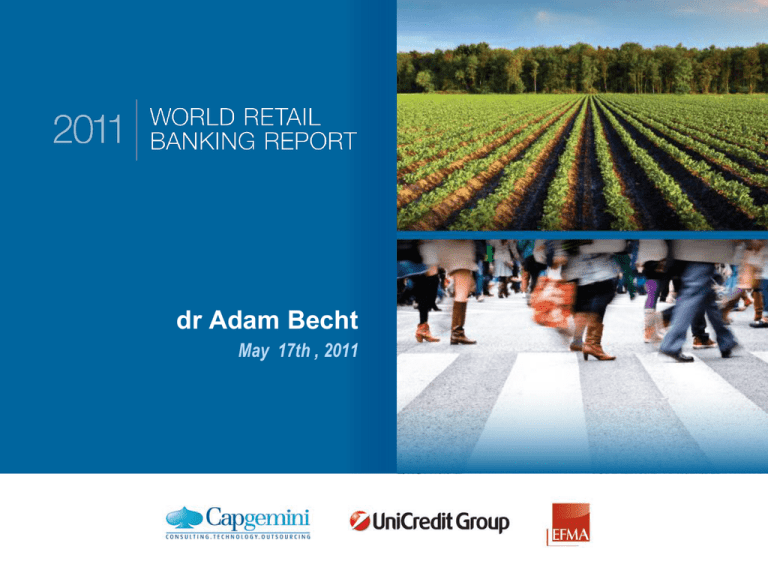
dr Adam Becht
May 17th , 2011
Each year Capgemini, in co-ordination with Unicredit and Efma,
publishes insights on the Retail Banking sector
2008
Organic Growth in
Domestic Markets
2009
Managing Mortgage
Profitability: Retail
Banks at a Crossroad
2010
2011
Small Business Banking
and the Crisis: Managing
development and risk
The Future Role of the
Branch in a Multi-Channel,
Multi-Product Environment
The World Retail Banking Report is a leading, industry report that provides strategic
insights into critical issues and trends impacting the global banking industry.
2
Capgemini Global Financial Services
2011 WRBR_Spokesperson Training Deck_26_v3.pptx
© 2011 Capgemini – All rights reserved
Contact Information
Key Findings Overview
3
Capgemini Global Financial Services
2011 WRBR_Spokesperson Training Deck_26_v3.pptx
© 2011 Capgemini – All rights reserved
The report’s findings draw on the ‘Voice of Customer’ survey data and
executive interviews with ~50 senior banking executives
Countries Included in Voice of Customer Survey and Region CEI Leaders, 2011
The 2011 WRBR highlights the top CEI ranked country in each of the five regions.
4
Capgemini Global Financial Services
2011 WRBR_Spokesperson Training Deck_26_v3.pptx
© 2011 Capgemini – All rights reserved
The 2011 WRBR proudly introduces the new ‘Customer
Experience Index’ and analyzes the Future Role of the Branch
Future Role of the Branch in a MultiChannel, Multi-Product Environment
Customer Experience Index
The CEI model provides information about how
customers are viewing the banking industry,
specifically what is important to customers and
how satisfied they are currently.
The branch channel remains a key
consideration in a firms overall retail delivery
strategy.
However, banks can not afford to let their
The model uncovers how customers interact
with the bank in regards to sales, service, and
information gathering across products and
channels.
branches stay stagnant but must transform
them to be an effective resource within a multiproduct, multi-channel environment.
Innovative trends and leading practices are
The model analyzes the experiences of
customers across select banking products and
channels. The typical banking lifecycle of the
average customer was divided into four
discrete stages in order to provide a more
granular view of the customer experience.
being implemented to overcome people,
process and technology challenges resulting
from the branch evolution which are converging
across four main areas: branch layout & design,
technology, sales & service, and staff & people .
5
Capgemini Global Financial Services
2011 WRBR_Spokesperson Training Deck_26_v3.pptx
© 2011 Capgemini – All rights reserved
The 2011 WRBR Customer Experience Index (CEI) measures
the customer experience across three dimensions
Dimensions of Capgemini’s Customer Experience Index (CEI)
• Current, Depository Accounts
& Payments
• Credit Cards
• Loans
• Mortgages
•
•
•
•
Information Gathering
Transacting
Problem Resolution
Account Status & History
CEI
Channels
• Branch
• Internet
• Mobile
• Phone
• ATM
The 2011 WRBR Voice of the Customer (VoC) provides insights into customer
perceptions and current satisfaction levels with retail banking products.
Source: Capgemini Analysis, 2011.
6
Capgemini Global Financial Services
2011 WRBR_Spokesperson Training Deck_26_v3.pptx
© 2011 Capgemini – All rights reserved
Key Findings from WRBR 2011
• Customers are generally satisfied, but opportunities exist to increase
satisfaction in the areas that matter most:
• Globally, banks’ success in delivering positive customer experiences is high, with a global average
Customer Experience Index rating of 72.2 out of 100.
• However, banks have been far less successful in generating high levels of satisfaction in the areas that
matter most to customers achieving a global average of only 35.8% of satisfaction with regards to
experience levers that are most important to customers.
• Channels are the key differentiators in satisfying customers on what they
perceive as important:
• Customers still consider the branch a top channel for carrying out their banking business, despite the
growing influence of direct channels. A shift is also underway as customers increasingly view the branch
as fulfilling an advisory role thought they still use the branch to carry out basic financial transactions.
• The branch is still a valued channel for customers, but it’s role must evolve to
meet changing preferences and expectations:
• Banks are evaluating six major themes for adoption as they transition their branch networks to play a more
effective role in today’s retail banking environment. While there is no “one-size-fits-all” approach, each
bank will gradually shift to one or more of these themes as they redefine their channel strategies.
7
Capgemini Global Financial Services
2011 WRBR_Spokesperson Training Deck_26_v3.pptx
© 2011 Capgemini – All rights reserved
Despite low levels of banking clients’ trust and confidence,
customers globally emerge quite satisfied with their banks
Customer Satisfaction with Primary Bank, Region Leaders (%), 2011
Although a majority of customers are generally satisfied with their primary banks,
opportunities still exist to enhance the overall banking customer experience.
Source: 2011 Retail Banking Voice of the Customer Survey, Capgemini, 2011
8
Capgemini Global Financial Services
2011 WRBR_Spokesperson Training Deck_26_v3.pptx
© 2011 Capgemini – All rights reserved
Globally, banks have been fairly successful in delivering a
positive level of overall customer experience
Customer Experience Index, Region Leaders, 2011
Four different regions were represented in the top six ranked CEI countries.
Source: 2011 Retail Banking Voice of the Customer Survey, Capgemini, 2011
9
Capgemini Global Financial Services
2011 WRBR_Spokesperson Training Deck_26_v3.pptx
© 2011 Capgemini – All rights reserved
Despite delivering an overall positive experience, banks in
most countries have not generated the ‘Wow’ factor
Customers with a Positive/Negative Experience, Region Leaders, (%), 2011
Banks will need to differentiate themselves from the competition by offering an
outstanding banking experience in the areas deemed most important by customers.
Source: 2011 Retail Banking Voice of the Customer Survey, Capgemini, 2011
10
Capgemini Global Financial Services
2011 WRBR_Spokesperson Training Deck_26_v3.pptx
© 2011 Capgemini – All rights reserved
High customer satisfaction levels of a bank do not always
translate to high positive customer experience levels
Positive Customer Satisfactiona Vs. Positive Customer Experienceb, 2011
While most countries had 50% - 70% of customers with positive satisfaction,
positive customer experience typically ranged from 30%-40%.
a) Positive Satisfaction has been defined as positive or very positive; b) Positive Experience has been defined as positive or very positive; Note: Only Top 10 CEI Countries labeled.
Source: 2011 Retail Banking Voice of the Customer Survey, Capgemini, 2011
11
Capgemini Global Financial Services
2011 WRBR_Spokesperson Training Deck_26_v3.pptx
© 2011 Capgemini – All rights reserved
Key Findings from WRBR 2011
• Customers are generally satisfied, but opportunities exist to increase
satisfaction in the areas that matter most:
• Globally, banks’ success in delivering positive customer experiences is high, with a global average
Customer Experience Index rating of 72.2 out of 100.
• However, banks have been far less successful in generating high levels of satisfaction in the areas that
matter most to customers achieving a global average of only 35.8% of satisfaction with regards to
experience levers that are most important to customers.
• Channels are the key differentiators in satisfying customers on what they
perceive as important:
• Customers still consider the branch a top channel for carrying out their banking business, despite the
growing influence of direct channels. A shift is also underway as customers increasingly view the branch
as fulfilling an advisory role thought they still use the branch to carry out basic financial transactions.
• The branch is still a valued channel for customers, but it’s role must evolve to
meet changing preferences and expectations:
• Banks are evaluating six major themes for adoption as they transition their branch networks to play a more
effective role in today’s retail banking environment. While there is no “one-size-fits-all” approach, each
bank will gradually shift to one or more of these themes as they redefine their channel strategies.
12
Capgemini Global Financial Services
2011 WRBR_Spokesperson Training Deck_26_v3.pptx
© 2011 Capgemini – All rights reserved
Satisfaction levels with most channels for each lifecycle
stage generally correlates to their perceived importance
Global Customer Importance Vs. Satisfaction of Channels by Life Cycle, across all Products, 2011
Importance and satisfaction for most lifecycles is highest with the internet and
lowest with mobile banking.
Source: 2011 Retail Banking Voice of the Customer Survey, Capgemini, 2011
13
Capgemini Global Financial Services
2011 WRBR_Spokesperson Training Deck_26_v3.pptx
© 2011 Capgemini – All rights reserved
Though online has emerged as a key banking channel,
branches remain important for daily banking activities
Customers still prefer visiting branches for problem resolution or buying complex
products such as loans and mortgages.
Source: 2011 Retail Banking Voice of the Customer Survey, Capgemini, 2011; Capgemini Analysis, 2011
Note: The importance of branch relative to direct channels by products and lifecycle stage is rated on a scale of 1-7 with 7 being very important and 1 being the not at all important
14
Capgemini Global Financial Services
2011 WRBR_Spokesperson Training Deck_26_v3.pptx
© 2011 Capgemini – All rights reserved
The internet and branch are the most successful channels
offering a positive experience across all age groups
Customers with a Positive Experience by Channel, Region, and Age (%), 2011
However, banks have not been successful in delivering as positive an experience
with the mobile and phone.
Source: Capgemini Analysis, 2011
15
Capgemini Global Financial Services
2011 WRBR_Spokesperson Training Deck_26_v3.pptx
© 2011 Capgemini – All rights reserved
Despite the growing influence of new channels, the branch
has remained a cornerstone of banks’ sales and service
The existence of large branch networks continue to create cost challenges for banks.
Source: Capgemini Analysis, 2011
17
Capgemini Global Financial Services
2011 WRBR_Spokesperson Training Deck_26_v3.pptx
© 2011 Capgemini – All rights reserved
Customers continue to see the branch as an important
channel for carrying out financial transactions
Most Important Role of the Branch to Customers in the Past, Present, and Future (%), 2011
Financial Transactions in the branch are
expected to continue to decline while
Advisory Services are expected to increase
Customers primarily visit the branch to carry out financial transactions but are
increasingly expecting advisory services and more relationship management.
Source: 2011 Retail Banking Voice of the Customer Survey, Capgemini, 2011; Capgemini Analysis, 2011
18
Capgemini Global Financial Services
2011 WRBR_Spokesperson Training Deck_26_v3.pptx
© 2011 Capgemini – All rights reserved
Key Findings from WRBR 2011
• Customers are generally satisfied, but opportunities exist to increase
satisfaction in the areas that matter most:
• Globally, banks’ success in delivering positive customer experiences is high, with a global average
Customer Experience Index rating of 72.2 out of 100.
• However, banks have been far less successful in generating high levels of satisfaction in the areas that
matter most to customers achieving a global average of only 35.8% of satisfaction with regards to
experience levers that are most important to customers.
• Channels are the key differentiators in satisfying customers on what they
perceive as important:
• Customers still consider the branch a top channel for carrying out their banking business, despite the
growing influence of direct channels. A shift is also underway as customers increasingly view the branch
as fulfilling an advisory role thought they still use the branch to carry out basic financial transactions.
• The branch is still a valued channel for customers but it’s role must evolve to
meet changing preferences and expectations:
• Banks are evaluating six major themes for adoption as they transition their branch networks to play a more
effective role in today’s retail banking environment. While there is no “one-size-fits-all” approach, each
bank will gradually shift to one or more of these themes as they redefine their channel strategies .
19
Capgemini Global Financial Services
2011 WRBR_Spokesperson Training Deck_26_v3.pptx
© 2011 Capgemini – All rights reserved
Positioning the branch to play an effective role in an overall
retail delivery strategy will require changes across four areas
Challenges
Emerging Trends
Challenges
Emerging Trends
Legacy Systems
Customer Analytics/
Business Intelligence
Outdated and Awkward
Layouts
Branch Re-Design
Seamless Multi-Channel
Integration
Format Optimization
Cross-Channel Integration
Adoption of Modern
Technologies
Customer
Analytics/Intelligence
Customer Personalization
Technologies
Adoption of Modern/
Innovative Technology
Customer Personalization
Technology
Technology
Challenges
Emerging Trends
Inefficient Sales Process
Targeted Service Strategies
for Customer Segments
Lack of Targeted Sales &
Service Strategies
Improving Efficiencies Across
Sales Process Through
Lack of Multi-Channel Sales
Automation
and Service Strategies
Multi-Channel Based Sales
Moving from Transactional to and Service Strategies
Relationship/ Advisory Based
Sales
Shifting from Transactional to
Advisory Relationship
Branch
Layout &
Design
Key Areas
Around
Branch
Transformation
Sales &
Service
Personalization and
Customization
In-Branch Service Model
Branch Automation to
Improve Convenience &
Service
Branch Layout Aligned with
Customer Needs
Customized Branches for
Different Customer
Segments
Staff &
People
Challenges
Emerging Trends
Outdated Skill-Sets of
Branch Staff
Empowerment of Branch
Staff
Lack of Authority to Act
Enhancing Quality of
Branch Staff
Misaligned Incentive
System
Unavailability of Tools
Recruitment & Training
of Branch Staff
Investments in Training
and Development of
Employees
Elevation of Customer
Experience as a KPIs for
Branch Staff
Source: Capgemini Analysis, 2011
20
Capgemini Global Financial Services
2011 WRBR_Spokesperson Training Deck_26_v3.pptx
© 2011 Capgemini – All rights reserved
Six themes are emerging around the future role of the branch
network in the retail banking space
Key Themes Emerging Around Future Role of the Branch Network, 2011
Physical Space for Virtual Relationship
Branchless
• Branch doesn’t handle transactions but
provides space for customers to come
and have video conferences with
specialists (mortgages, investments)
• Banks that are strictly online or
mobile and do not have a brick and
mortar presence
Independent Network
• Banks use a space that doesn’t belong
to them such as a post office,
supermarket or pharmacy allowing
customers to bank while doing other
activities
Core of a Multi-Channel Network
• Branch is at the core of the network and
owns the customers
Bank Branch
Seamless Multi-Channel Network
Trusted Advisor
• Customers have a consistent experience
that allows them to start/stop any
transactions seamlessly utilizing any
channel for the banking relationship
• Banks wants the branch to be viewed
as a trusted advisor and prefers for the
customer to handle day to day banking
transactions through other channels
There is no one size fit all approach and banks will adapt one or more of these themes
depending on their channel and business strategy.
Source: Capgemini Analysis, 2011
21
Capgemini Global Financial Services
2011 WRBR_Spokesperson Training Deck_26_v3.pptx
© 2011 Capgemini – All rights reserved
‘Branch at the Core of a Multi-Channel Network’ and is the key
relationship hub between the bank and its customers
Branch at the Core of a Multi-Channel Network
Commentary
• The branch is at the center of the customer
relationship where they open and manage
customer relationships, providing a full
array of advisory and day-to-day
transactional services.
• Direct channels are deployed more as aids
for basic financial transactions or
information gathering
• Advantages:
• Ideal for attracting high-value customers
• Advisory services for more complex products
and services w/ higher margins
• Disadvantages:
• High overhead and operating costs for people
and technology
• Maintaining and updating branch designs and
layouts
Source: Capgemini Analysis, 2011
22
Capgemini Global Financial Services
2011 WRBR_Spokesperson Training Deck_26_v3.pptx
© 2011 Capgemini – All rights reserved
‘Branch As a Trusted Advisor for Customers’ with all the day-today banking transactions moving to direct/ alternate channels
Branch As a Trusted Advisor for Customers
Commentary
• The branch provides advisory services and
builds the relationship, as daily financial
transactions move to direct channels
• The branch manages the relationship with
predictive sales processes and excellent
customer support
• Advantages:
• Focus on profitable high-margin sales
• Clear customer segmentation based on
relationship management
• Disadvantages:
• Significant training to upgrade staff skill sets
for regulatory requirements and to understand
needs-based selling
• Investments to maintain and keep direct
channels functioning well so customers utilize
those channels for basic transactions
Source: Capgemini Analysis, 2011
23
Capgemini Global Financial Services
2011 WRBR_Spokesperson Training Deck_26_v3.pptx
© 2011 Capgemini – All rights reserved
Moving branches to ‘Independent Networks’ where current and
prospective customers visit frequently to improve access to banks
Branch As an Independent Network
Commentary
• Branches are positioned in unconventional
locations such as, grocery stores, super
markets, and pharmacies to provide banking
services at the customer’s convenience
• Advantages:
• Minimal marketing expenses for customer
acquisition due to a built-in client base
• Reduced cost by utilizing existing infrastructure
• Strong deposit gathering capabilities
• Disadvantages:
• Simple products with no customization or
personalization
• Regulatory compliance and privacy laws
related to sharing customer data
• Bank partner may decide to become a
competitor (i.e., Wal-Mart and Tesco)
Source: Capgemini Analysis, 2011
24
Capgemini Global Financial Services
2011 WRBR_Spokesperson Training Deck_26_v3.pptx
© 2011 Capgemini – All rights reserved
The ‘Branchless Bank’ has attracted a loyal customer base due to
high interest rates and convenience/ease of use
The Branchless Bank
Commentary
• Branchless banks have no brick-and-mortar
presence allowing the channel to own the
customer relationship while delivering
banking sales and services
• Direct banks enter the market with either a
full banking or niche product approach
• Advantages:
• Greatly reduced cost structure
• Can offer lower fees and higher rates on
products
• Disadvantages:
• No physical location for clients to visit
• Reliance on strong marketing campaigns to
attract new customers
• May attract “rate chasers” and fail to develop a
loyal customer base
Source: Capgemini Analysis, 2011
25
Capgemini Global Financial Services
2011 WRBR_Spokesperson Training Deck_26_v3.pptx
© 2011 Capgemini – All rights reserved
‘Branch As a Part of a Seamless Multi-Channel Network’ where
the customer relationship is managed through multiple channels
Branch As a Part of Seamless Multi-Channel Network
Commentary
TWITTER
FACEBOOK
• The branch is an equal partner with the direct
channels in managing the customer
relationship. This approach recognizes the
branch is important but direct channels have
become essential elements for retail delivery.
• Advantages:
• Strong competitive advantage in the market
• Clear customer segmentation and clearly
defined product offerings
• Elimination of channel conflicts related to
customer ownership and revenue
• Disadvantages:
• Large investments to integrate all channels
• Internal change management issues related to
breaking down channel silos
• Maintenance expenses related to technology to
keep channels functioning properly
Source: Capgemini Analysis, 2011; Multichannel Banking in Europe, Finalta, 2011
26
Capgemini Global Financial Services
2011 WRBR_Spokesperson Training Deck_26_v3.pptx
© 2011 Capgemini – All rights reserved
‘Branch As a Physical Space for Virtual Interactions’ helps in
enhancing trust and create brand awareness amongst customers
Branch as a Physical Space for Virtual Relationship Management
Commentary
• The branch provides a physical space for
customers executing virtual interactions or
banking transactions
• Branches also act as experience centers
designed to reinforce a particular brand
image or value proposition
• Advantages:
• Recognized by customers and the market as
innovators
• Unique way of connecting with and engaging
clients
• Disadvantages:
• Expensive to redesign or build branches for
this approach
• Training to upgrade staff skill sets
• Changing customer perceptions to accept new
concept
Source: Capgemini Analysis, 2011
27
Capgemini Global Financial Services
2011 WRBR_Spokesperson Training Deck_26_v3.pptx
© 2011 Capgemini – All rights reserved
Deciding how best to leverage the branch network will require a
thorough consideration and analysis of the themes
Advantages and Challenges for Banks While Adopting Emerging Themes
• Challenges
• Advantages
Branchless
Banking
• Increased
convenience/
accessibility
Branch Is a Bank
Branch As an Advisor
• Personal relationship/
face to face interaction
• Clear client
segmentation
• Attracts high value
transactions & clients
to branch
• Product offerings
are aligned to the
segments
• Overhead costs
savings helps
pay higher
interest rates or
charge lesser fee
• Delivers advisory
services
• Branch are purely
advisory oriented
with Low value
transactions pushed
to direct channels
• Limited and basic
products on offer
• High operating costs
(People, technology)
• Up-skilling of branch
staff
• Regulatory
barriers limits
banks to the
extent they can
leverage direct
channels
• Requires highly trained
staff
• Renewed strategy
to hire right skills
• Price is the
biggest
differentiator
• Sophisticated
technology upgrades
required
• Reduction in
operating costs
• High investment
required in existing
branches
• Invest to build
strong multi-channel
capabilities and
automation
Multi-Channel
Integration
• Strong multichannel
capabilities
• Different
channels have
different roles
for different
client segments
• Client
satisfaction
oriented service
delivery
• High degree of
business
transformation
risk
• Huge upfront
investment to
upgrade
systems/
technology
Independent
Network Banks
Physical Space
• Accessible to a
large client base
• Encourages client
self-service
• Reduced operating
cost
• Deferred model
that piggy backs
on an existing
relationship
• Only sell simple
products
• Innovative and
unique concept
to enhance
client
engagement
and service
• Strongly
reinforce banks
brand image
and value
proposition
• High input cost
with un-tangible
benefits
• Bank partner can
become
competitor, e.g.
Tesco Banks
• Advanced system
support required
• Data sharing may
lead to privacy
issues
• Banks have to
make efforts to
shift client
perception to
accept the new
concept
branches
Banks are not limited to only one theme but may implement various themes across
different regions or demographics depending on their strategy and business priorities.
Source: Capgemini Analysis, 2011
28
Capgemini Global Financial Services
2011 WRBR_Spokesperson Training Deck_26_v3.pptx
© 2011 Capgemini – All rights reserved
Conclusion
• Despite customers’ lack of trust in the banking system, globally, banks have done relatively well
ensuring customers are satisfied:
• However, the number of customers having a positive customer experience around levers most important
to them is not as high, putting banks at the risk of losing customers unless they significantly improve the
customer experience
• Identifying the factors of greatest importance to their customers and then delivering on those dimensions
will help banks drive positive customer experience
• Globally, customers have the most positive customer experience with the branch and the internet,
the least positive with mobile banking:
• While customers perceive the internet as the most important channel for most lifecycle stages, they still
view the branch as the most important channel for problem solving, suggesting customers prefer a
human touch in certain interactions with the bank.
• The branch is still a valued channel and banks are transforming them to meet changing customer
preferences and expectations:
• Innovative trends and leading practices are being implemented globally and regionally to overcome
people, process and technology challenges resulting from the branch evolution.
• Determining how to leverage the branch in a multi-product, multi-channel environment remains a
key consideration in a firms overall retail delivery strategy:
• Six key themes are shaping the channel landscape and redefining the future role of the branch. Banks
are not limited by only one theme but have the ability to implement various themes across different
regions or demographics depending on their business priorities and targeted customer base.
31
Capgemini Global Financial Services
2011 WRBR_Spokesperson Training Deck_26_v3.pptx
© 2011 Capgemini – All rights reserved
www.capgemini.com/financialservices








